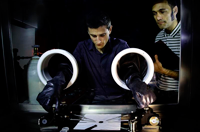 A three year project undertaken at the US Sandia National Laboratories has determined the flow of lithium ions across battery interfaces is a major obstacle to efforts to improve solid-state lithium-ion battery performance.
A three year project undertaken at the US Sandia National Laboratories has determined the flow of lithium ions across battery interfaces is a major obstacle to efforts to improve solid-state lithium-ion battery performance.
“The underlying goal of the work is to make solid-state batteries more efficient and to improve the interfaces between different materials,” said Sandia physicist Farid El Gabaly. “In this project, all the materials are solid; we don’t have a liquid-solid interface like in traditional lithium-ion batteries.”
El Gabaly explained that, in any lithium battery, lithium must travel from one electrode to the other when it is charged and discharged. However, the mobility of lithium ions is not the same in all materials and interfaces between materials are a major obstacle.
According to El Gabaly, there are two important interfaces in solid state batteries – the cathode-electrolyte and electrolyte-anode junctions – and either could dictate the performance limits of a full battery.
Fellow researcher Forrest Gittleson noted: “When we identify one of these bottlenecks, we ask ‘can we modify it?’. Then we try to change the interface and make the chemical processes more stable over time.”
El Gabaly said Sandia is interested in the research mainly because solid-state batteries are low maintenance, reliable and safe. “Our focus wasn’t on large batteries, like in electric vehicles. It was more for small or integrated electronics.”
Sandia’s California laboratory has not conducted research into solid-state batteries, which meant the project had to work out how to prototype batteries and examine their interfaces. The research was conducted using materials that have been used in previous proof-of-concept solid-state batteries.
“Since these materials are not produced on a massive commercial scale, we needed to be able to fabricate full devices on-site,” El Gabaly explained. “We sought methods to improve the batteries by either inserting or changing the interfaces in various ways or exchanging materials.”
The next phase of the research is to improve the performance of the batteries and to assemble them alongside other Sandia technologies.
“We can now start combining our batteries with LEDs, sensors, small antennas or any number of integrated devices,” El Gabaly said. “Even though we are happy with our battery performance, we can always try to improve it.”
Author
Graham Pitcher
Source: www.newelectronics.co.uk
